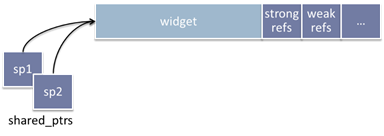GotW #89 Solution: Smart Pointers
来源:互联网 发布:网络交友的危害的例子 编辑:程序博客网 时间:2024/06/10 18:11
There’s a lot to love about standard smart pointers in general, and unique_ptr in particular.
Problem
JG Question
1. When should you use shared_ptr vs. unique_ptr? List as many considerations as you can.
Guru Question
2. Why should you almost always use make_shared to create an object to be owned byshared_ptrs? Explain.
3. Why should you almost always use make_unique to create an object to be initially owned by aunique_ptr? Explain.
4. What’s the deal with auto_ptr?
Solution
1. When should you use shared_ptr vs. unique_ptr?
When in doubt, prefer unique_ptr by default, and you can always later move-convert toshared_ptr if you need it. If you do know from the start you need shared ownership, however, go directly toshared_ptr via make_shared (see #2 below).
There are three major reasons to say “when in doubt, prefer unique_ptr.”
First, use the simplest semantics that are sufficient: Choose the right smart pointer to most directly express your intent, and what you need (now). If you are creating a new object and don’t know that you’ll eventually need shared ownership, useunique_ptr which expresses unique ownership. You can still put it in a container (e.g.,vector<unique_ptr<widget>>) and do most other things you want to do with a raw pointer, only safely. If you later need shared ownership, you can always move-convert theunique_ptr to a shared_ptr.
Second, a unique_ptr is more efficient than ashared_ptr. A unique_ptr doesn’t need to maintain reference count information and a control block under the covers, and is designed to be just about as cheap to move and use as a raw pointer. When you don’t ask for more than you need, you don’t incur overheads you won’t use.
Third, starting with unique_ptr is more flexible and keeps your options open. If you start with aunique_ptr, you can always later convert to a shared_ptr via move, or to another custom smart pointer (or even to a raw pointer) via.get() or .release().
Guideline: Prefer to use the standard smart pointers, unique_ptr by default and shared_ptr if sharing is needed. They are the common types that all C++ libraries can understand. Use other smart pointer types only if necessary for interoperability with other libraries, or when necessary for custom behavior you can’t achieve with deleters and allocators on the standard pointers.
2. Why should you almost always use make_shared to create an object to be owned by shared_ptrs? Explain.
Note: If you need to create an object using a custom allocator, which is rare, you can useallocate_shared. Note that even though its name is slightly different,allocate_shared should be viewed as “just the flavor ofmake_shared that lets you specify an allocator,” so I’m mainly going to talk about them both asmake_shared here and not distinguish much between them.
There are two main cases where you can’t use make_shared (orallocate_shared) to create an object that you know will be owned byshared_ptrs: (a) if you need a custom deleter, such as because of usingshared_ptrs to manage a non-memory resource or an object allocated in a nonstandard memory area, you can’t usemake_shared because it doesn’t support specifying a deleter; and (b) if you are adopting a raw pointer to an object being handed to you from other (usually legacy) code, you would construct ashared_ptr from that raw pointer directly.
Guideline: Use make_shared (or, if you need a custom allocator,allocate_shared) to create an object you know will be owned by shared_ptrs, unless you need a custom deleter or are adopting a raw pointer from elsewhere.
So, why use make_shared (or, if you need a custom allocator,allocate_shared) whenever you can, which is nearly always? There are two main reasons: simplicity, and efficiency.
First, with make_shared the code is simpler. Write for clarity and correctness first.
Second, using make_shared is more efficient. Theshared_ptr implementation has to maintain housekeeping information in a control block shared by allshared_ptrs and weak_ptrs referring to a given object. In particular, that housekeeping information has to include not just one but two reference counts:
- A “strong reference” count to track the number of shared_ptrs currently keeping the object alive. The shared object is destroyed (and possibly deallocated) when the last strong reference goes away.
- A “weak reference” count to track the number of weak_ptrs currently observing the object. The shared housekeeping control block is destroyed and deallocated (and the shared object is deallocated if it was not already) when the last weak reference goes away.
If you allocate the object separately via a raw new expression, then pass it toa shared_ptr, the shared_ptr implementation has no alternative but to allocate the control block separately, as shown in Example 2(a) and Figure 2(a).
// Example 2(a): Separate allocationauto sp1 = shared_ptr<widget>{ new widget{} };auto sp2 = sp1;
Figure 2(a): Approximate memory layout for Example 2(a).
We’d like to avoid doing two separate allocations here. If you use make_shared to allocate the object and the shared_ptr all in one go, then the implementation can fold them together in a single allocation, as shown in Example 2(b) and Figure 2(b).
// Example 2(b): Single allocationauto sp1 = make_shared<widget>();auto sp2 = sp1;
Figure 2(b): Approximate memory layout for Example 2(b).
Note that combining the allocations has two major advantages:
- It reduces allocation overhead, including memory fragmentation. First, the most obvious way it does this is by reducing the number of allocation requests, which are typically more expensive operations. This also helps reduce contention on allocators (some allocators don’t scale well). Second, using only one chunk of memory instead of two reduces the per-allocation overhead. Whenever you ask for a chunk of memory, the system must give you at least that many bytes, and often gives you a few more because of using fixed-size pools or tacking on housekeeping information per allocation. So by using a single chunk of memory, we tend to reduce the total extra overhead. Finally, we also naturally reduce the number of “dead” extra in-between gaps that cause fragmentation.
- It improves locality. The reference counts are frequently used with the object, and for small objects are likely to be on the same cache line, which improves cache performance (as long as there isn’t some thread copying the smart pointer in a tight loop; don’t do that).
As always, when you can express more of what you’re trying to achieve as a single function call, you’re giving the system a better chance to figure out a way to do the job more efficiently. This is just as true when inserting 100 elements into avector using a single range-insert call to v.insert( first, last ) instead of 100 calls to v.insert( value ) as it is when using a single call to make_shared instead of separate calls to new widget() andshared_ptr( widget* ).
There are two more advantages: Using make_shared avoids explicitnew and avoids an exception safety issue. Both of these also apply tomake_unique, so we’ll cover them under #3.
3. Why should you almost always use make_unique to create an object to be initially owned by a unique_ptr? Explain.
As with make_shared, there are two main cases where you can’t usemake_unique to create an object that you know will be owned (at least initially) by aunique_ptr: if you need a custom deleter, or if you are adopting a raw pointer.
Otherwise, which is nearly always, prefer make_unique.
Guideline: Use make_unique to create an object that isn’t shared (at least not yet), unless you need a custom deleter or are adopting a raw pointer from elsewhere.
Besides symmetry with make_shared, make_unique offers at least two other advantages. First, you should prefer usemake_unique<T>() instead of the more-verbose unique_ptr<T>{ new T{} } because you should avoid explicit new in general:
Guideline: Don’t use explicit new, delete, and owning* pointers, except in rare cases encapsulated inside the implementation of a low-level data structure.
Second, it avoids some known exception safety issues with naked new. Here’s an example:
void sink( unique_ptr<widget>, unique_ptr<gadget> );sink( unique_ptr<widget>{new widget{}}, unique_ptr<gadget>{new gadget{}} ); // Q1: do you see the problem?Briefly, if you allocate and construct the new widget first, then get an exception while allocating or constructing thenew gadget, the widget is leaked. You might think: “Well, I could just changenew widget{} to make_unique<widget>() and this problem would go away, right?” To wit:
sink( make_unique<widget>(), unique_ptr<gadget>{new gadget{}} ); // Q2: is this better?The answer is no, because C++ leaves the order of evaluation of function arguments unspecified and so either thenew widget or the new gadget could be performed first. If the new gadget is allocated and constructed first, then themake_unique<widget> throws, we have the same problem.
But while just changing one of the arguments to use make_unique doesn’t close the hole, changing them both to make_unique really does completely eliminate the problem:
sink( make_unique<widget>(), make_unique<gadget>() ); // exception-safeThis exception safety issue is covered in more detail in GotW #56.
Guideline: To allocate an object, prefer to write make_unique by default, and writemake_shared when you know the object’s lifetime is going to be managed by usingshared_ptrs.
4. What’s the deal with auto_ptr?
auto_ptr is most charitably characterized as a valiant attempt to create aunique_ptr before C++ had move semantics. auto_ptr is now deprecated, and should not be used in new code.
If you have auto_ptr in an existing code base, when you get a chance try doing a global search-and-replace ofauto_ptr to unique_ptr; the vast majority of uses will work the same, and it might expose (as a compile-time error) or fix (silently) a bug or two you didn’t know you had.
Acknowledgments
Thanks in particular to the following for their feedback to improve this article: celeborn2bealive, Andy Prowl, Chris Vine, Marek.
- GotW #89 Solution: Smart Pointers
- Smart pointers
- Smart Pointers
- Templates and Smart Pointers
- smart pointers 2
- Reference Counted Smart Pointers
- Smart Pointers in Boost
- Smart Pointers智能指针
- Smart Pointers in C++
- 智能指针(Smart Pointers)
- C++11 Smart Pointers
- Solution: Smart Pointer Parameters
- Smart Pointers : What , Why , Which?
- A TR1 Tutorial: Smart Pointers
- Basic properties of smart pointers
- Smart Pointers - What, Why, Which?
- Smart Pointers - What, Why, Which?
- Implementing operator->* for Smart Pointers
- NSDate类以及category
- 虚拟化对网络的要求
- Hibernate HQL语句总结
- ios的post提交
- excel 2007 冻结单元格
- GotW #89 Solution: Smart Pointers
- 有一个数组,数组中有13个元素,先将该数组进行分组,每3个元素为一组,分为若干组,最后用一个数组统一管理这些分组.(要动态创建数组).
- 手机app以数据流格式传图片php接受并保存服务器
- itoa和atoi的用法及功能
- Matlab常用对话框--------文件打开对话框(uigetfile)
- C++ Boost Thread 编程指南
- poj 1548
- Android Volley完全解析(一),初识Volley的基本用法
- 同步与异步的概念


